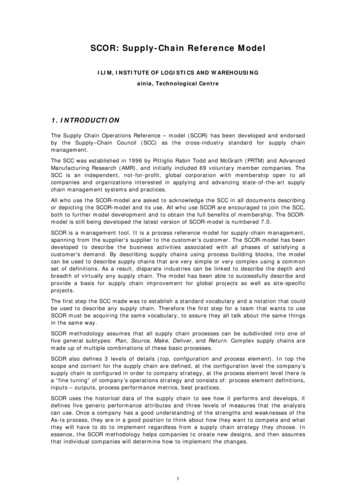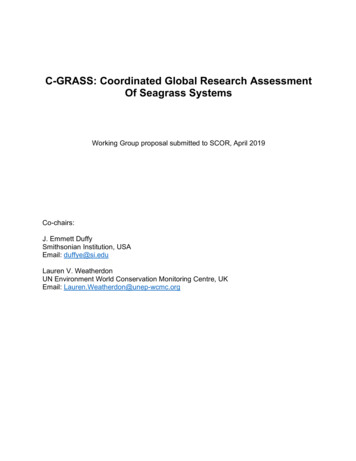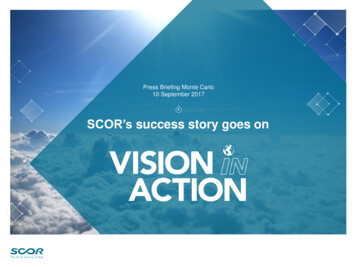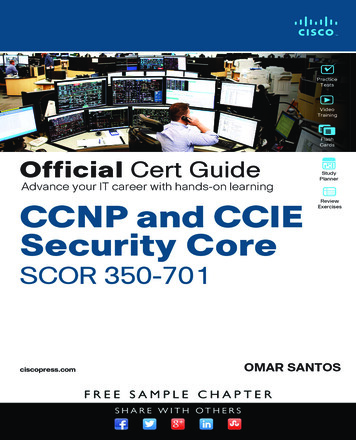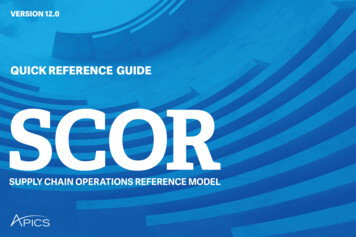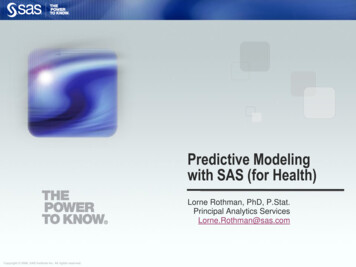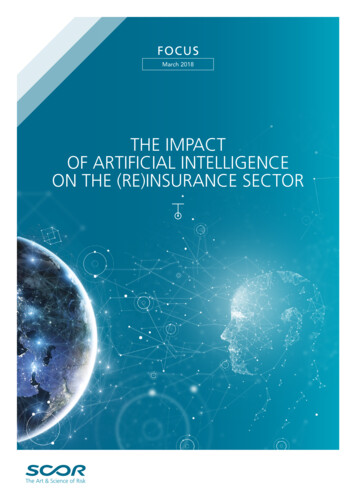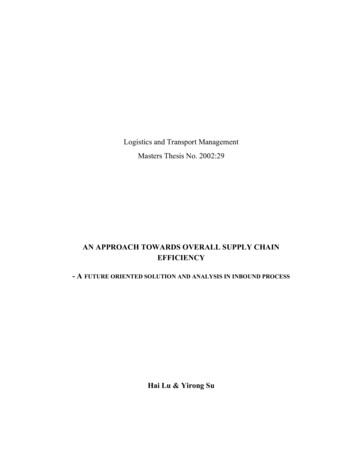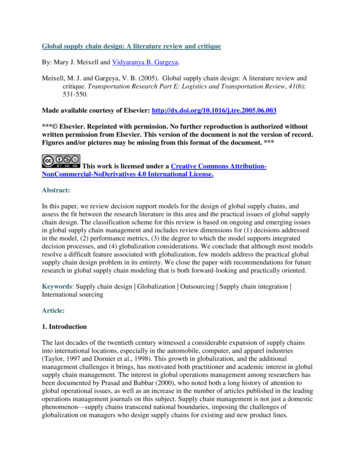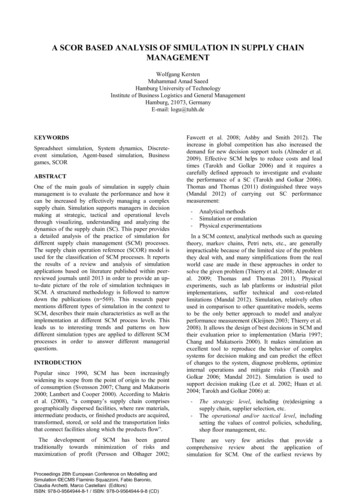
Transcription
A SCOR BASED ANALYSIS OF SIMULATION IN SUPPLY CHAINMANAGEMENTWolfgang KerstenMuhammad Amad SaeedHamburg University of TechnologyInstitute of Business Logistics and General ManagementHamburg, 21073, GermanyE-mail: logu@tuhh.deKEYWORDSSpreadsheet simulation, System dynamics, Discreteevent simulation, Agent-based simulation, Businessgames, SCORABSTRACTOne of the main goals of simulation in supply chainmanagement is to evaluate the performance and how itcan be increased by effectively managing a complexsupply chain. Simulation supports managers in decisionmaking at strategic, tactical and operational levelsthrough visualizing, understanding and analyzing thedynamics of the supply chain (SC). This paper providesa detailed analysis of the practice of simulation fordifferent supply chain management (SCM) processes.The supply chain operation reference (SCOR) model isused for the classification of SCM processes. It reportsthe results of a review and analysis of simulationapplications based on literature published within peerreviewed journals until 2013 in order to provide an upto-date picture of the role of simulation techniques inSCM. A structured methodology is followed to narrowdown the publications (n 569). This research papermentions different types of simulation in the context toSCM, describes their main characteristics as well as theimplementation at different SCM process levels. Thisleads us to interesting trends and patterns on howdifferent simulation types are applied to different SCMprocesses in order to answer different managerialquestions.INTRODUCTIONPopular since 1990, SCM has been increasinglywidening its scope from the point of origin to the pointof consumption (Svensson 2007; Chang and Makatsoris2000; Lambert and Cooper 2000). According to Makriset al. (2008), “a company’s supply chain comprisesgeographically dispersed facilities, where raw materials,intermediate products, or finished products are acquired,transformed, stored, or sold and the transportation linksthat connect facilities along which the products flow”.The development of SCM has been gearedtraditionally towards minimization of risks andmaximization of profit (Persson and Olhager 2002;Proceedings 28th European Conference on Modelling andSimulation ECMS Flaminio Squazzoni, Fabio Baronio,Claudia Archetti, Marco Castellani (Editors)ISBN: 978-0-9564944-8-1 / ISBN: 978-0-9564944-9-8 (CD)Fawcett et al. 2008; Ashby and Smith 2012). Theincrease in global competition has also increased thedemand for new decision support tools (Almeder et al.2009). Effective SCM helps to reduce costs and leadtimes (Tarokh and Golkar 2006) and it requires acarefully defined approach to investigate and evaluatethe performance of a SC (Tarokh and Golkar 2006).Thomas and Thomas (2011) distinguished three ways(Mandal 2012) of carrying out SC performancemeasurement:-Analytical methodsSimulation or emulationPhysical experimentationsIn a SCM context, analytical methods such as queuingtheory, markov chains, Petri nets, etc., are generallyimpracticable because of the limited size of the problemthey deal with, and many simplifications from the realworld case are made in these approaches in order tosolve the given problem (Thierry et al. 2008; Almeder etal. 2009; Thomas and Thomas 2011). Physicalexperiments, such as lab platforms or industrial pilotimplementations, suffer technical and cost-relatedlimitations (Mandal 2012). Simulation, relatively oftenused in comparison to other quantitative models, seemsto be the only better approach to model and analyzeperformance measurement (Kleijnen 2003; Thierry et al.2008). It allows the design of best decisions in SCM andtheir evaluation prior to implementation (Maria 1997;Chang and Makatsoris 2000). It makes simulation anexcellent tool to reproduce the behavior of complexsystems for decision making and can predict the effectof changes to the system, diagnose problems, optimizeinternal operations and mitigate risks (Tarokh andGolkar 2006; Mandal 2012). Simulation is used tosupport decision making (Lee et al. 2002; Huan et al.2004; Tarokh and Golkar 2006) at:-The strategic level, including (re)designing asupply chain, supplier selection, etc.The operational and/or tactical level, includingsetting the values of control policies, scheduling,shop floor management, etc.There are very few articles that provide acomprehensive review about the application ofsimulation for SCM. One of the earliest reviews by
Kleijnen (2005) explained the use of simulation forSCM and distinguished four simulation types for SCMbut did not provide the analysis of the application ofdifferent simulation approaches for various SCMprocesses. Tarokh and Golkar (2006) explained howdifferent simulation types can answer different questionsin SCM. Jahangirian et al. (2010) have included abroader range of simulation techniques in manufacturingand business sectors. Tako and Robinson (2012) havegiven a useful discussion by considering only discreteevent simulation and system dynamics in the context ofLogistics and SC. Othman and Mustaffa (2012) havereviewed different simulation and optimizationtechniques and analyzed simulation software tools thatare being used for SCM, while Mandal (2012) explainedthe use of simulation for performance measurement inSCM. However, these reviews did not provide acomprehensive conjoint or cross-functional analysis ofthe application of different simulation approaches forvarious SCM processes. Therefore, the aim of ourliterature review is to fill this gap through an extensivecoverage of existing academic literature in the field ofsimulation in SCM and focusing specifically to SCORbased SCM processes.REVIEW OF SUPPLY CHAIN SIMULATIONMETHODSComputer simulation is the experimentation with acomputer model of the system to answer “what-if”questions about the system (Bowden 1998; Seila 2006)and to support decision makers in designing SCoperations in order to study their collective and dynamicbehaviors (Yancez 2009). In the mid 90’s a largenumber of software packages, used to support SCMoperations, have emerged that are called supply chainmanagement systems (Chang and Makatsoris 2000).From scanning of established literature, five simulations(Kleijnen and Smits 2003; Allwood and Lee 2005; Haoand Shen 2008; Yanez et al. 2009; Jain et al. 2013;Kocaoglu et al. 2013) approaches were distinguishedthat are used in context of SCM:-Spreadsheet simulationSystem dynamicDiscrete-event simulationAgent-based simulationBusiness gameA simulation model of a SC can be an entire orstandalone model reproducing all nodes, or using moreintegrated models (one for each node) (Terzia andCavalierib 2004; Thierry et al. 2008).Spreadsheet Simulation“Spreadsheet simulation” refers to the use of aspreadsheet as a platform for representing simulationmodels and performing simulation experiments (Seila2006; Othman and Mustafa 2012). It can be used forsampling distribution, test of hypotheses, etc., (Johnson2011). Spreadsheet simulation is often a simple,economical and relatively straightforward approach. It ispossible to develop a simple time slice model but it isdifficult to develop a model animation (Kleijnen 2005;Othman and Mustafa 2012; Mishra and Chan 2012).The most prevalent spreadsheet today is MicrosoftExcel, which is part of the Microsoft Office package(Greasley 1998; Seila 2006). Any set of calculations in aspreadsheet can be considered as a model. In severalstudies spreadsheet simulation has not been cited as aformal method of analyzing SCM (Othman and Mustafa2012) but in a business setting the spreadsheet platformis available to a wide range of decision making(Greasley 1998; Othman and Mustafa 2012) e.g. Koo etal. (1994) used spreadsheet for performance evaluationof a manufacturing system, Sui et al. (2010) used it todetermine the replenishment policy in a vendor managedinventory system. Spreadsheet is a tool which can becombined with all other simulation approaches (Thierryet al. 2008).System DynamicsAccording to Labarthe et al. (2007) supply chainmodeling and simulation was originally based on systemdynamics. System dynamics (SD) is a simulation inwhich the state of a system varies continuously (Takoand Robinson 2012; Mandal 2012). In system dynamics,firms are viewed as complex systems with differenttypes of flows (e.g. material, orders, manpower,technology, etc.) and stocks (e.g. WIP at a given point intime) (Kleijnen 2005). System dynamics is based onflow models where it is not possible to differentiatebetween individual elements (Mandal 2012). Themanagerial control is realized by changing the rate ofvariables (Kleijnen 2005) (e.g. production rate, salesrate, etc.), which will change the flow as well as thestocks. A SD model takes the feedback principle (closedloop effect) into account which plays a crucial role i.e.managers will take corrective actions if there is anundesirable variation of a targeted value of aperformance indicator (Kleijnen 2003; Thierry et al.2008; Mandal 2012).Discrete-event SimulationDiscrete event simulation (DES), as the name implies, isa simulation where state changes occur at discrete pointsin time (Mandal 2012) and is widely used for SCplanning (Almeder et al. 2009; Tako and Robinson2012). A DES is more detailed than the previous twosimulation types (Kleijnen & Smits 2003). It representsindividual events, e.g. arrival of an individual customerorder or the departure of a production lot (Kleijnen2003). DES is an important method in SCM and used tosupport decision making for different SCM processes,e.g. Finke et al. (2012) used DES to study changes inproduction lead time if there are disruptions inoperations of an individual processing time of a task.According to Tako and Robinson (2012), hybrid
simulation approaches were used to model SCMprocesses to support strategic decision making as DESdoes not represent systems at an aggregate level. Lee etal. (2002) proposed a combined modeling architecturefor SC simulation, in which they presented a simpleexample of a supply chain model dealing at strategiclevel of a supply chain.Agent-based SimulationOver the last few years, agent-based systems arebecoming more and more effective tools for solvingSCM problems (Mele et al. 2007). So this simulationapproach should be added to the above set of simulationapproaches for SCM (Eldabi et al. 2008; Yanez et al.2009). In agent-based simulation, an agent is a real orvirtual entity that encapsulates the behaviors of differententities and acts on itself and its surrounding world(Saberi et al. 2012; Ilie-Zudor and Monostori 2009).The multi-agent system (MAS) collaborates, andconsiders exchange of information and relationshipsamong other agents in order to obtain improvedsolutions (Nikolopoulou and Ierapetritou 2012). Supplychain activities such as sourcing, planning, delivery andtheir interactions are represented by different agents inmulti-agent systems (Saberi et al. 2012). Agents areautonomous, reactive, and proactive and have socialability (Julka et al. 2002). Due to these advantages,MAS have become a promising tool for solving SCMproblems in the last few years (Puigjaner and Gosalbez2008).Business GamesModeling of human behavior is more difficult incomparison to modeling of different SCM processes(Kleijnen 2005). It can be achieved by letting managersoperate within a simulated world (consisting of SC andits environment) (Kleijnen and Smits 2003; Mandal2012). Business games are used for educational andresearch goals (Kleijnen 2003) and have norelationships to game theory which is applied to SC(Mandal 2012). The beer game is widely used amongseveral proposed games (Mandal 2012). Kleijnen andSmits (2003) distinguished business games in twosubtypes:i.ii.In Strategic games several teams of players(representing companies) compete with each other.Players interact with the simulation model for afixed number of rounds, like beer game which isused to illustrate the bullwhip effect (Kleijnen2005; Thierry et al. 2008).In the simulated world of Operational games, asingle team (one or more players at a time)interacts with a simulation model for severalrounds, like games for training of productionscheduling (Kleijnen 2003; Thierry et al. 2008).Furthermore, based on complexity level, Thierry et al.(2008) categorized business games as board games(simple) that are played with tokens on specific boardsand sophisticated games (more realistic) that run oncomputer devices.The type of simulation applied in SCM depends on theproblem that needs to be solved e.g. use of SDdemonstrates the bullwhip effect, DES simulation canquantify fill rates, use of business games to educate andtrain users (Kleijnen 2003).CLASSIFICATION OF SUPPLY CHAINMANAGEMENT PROCESSES BASED ON SCORMODELEvery business process has different characteristics.Thus a good understanding of the SCM processes isnecessary before developing a simulation model (Changand Makatsoris 2000). In the past, different metrics wereused to measure performance at different SC levels andmodels for decisions making at strategic level are scarce(Huan et al. 2004). It is not achievable to have a modelthat perfectly represent SCM but a closely adaptedmodel (Irfan et al. 2008; Mandal 2012) i.e. SCOR. In1996, the Supply Chain Council (SCC) has developedand released a structured framework model ‘SCOR’ forSCM systems and practices (Li et al. 2011). SCORmodel is the first cross-industry framework forevaluating and improving SC performance andmanagement (Stewart 1997; Huan et al. 2004). Thebenefit of the ‘SCOR’ model is that it provides astandard format and a comprehensive methodology tofacilitate communication and to improve SC operations(Irfan et al. 2008). It is a flexible framework andcommon language that can help upper management of afirm to design and reconfigure its SC to achieve thedesired performance both internally and externally(Huan et al. 2004). SCOR is widely used in academiaand practice. For these reasons we use the SCORframework as a base of our analysis.‘SCOR’ is a business process framework that spansfrom the supplier’s supplier to the customer’s customer(‘SCOR’ 2012). ‘SCOR 11.0’ describes a SC by fourlevels of details. Level 1 is a top level that defines thescope and high level configuration by six coreprocesses, i.e. plan, source, make, deliver, return andenable. Level 2 is a configuration level and processes atlevel 2, along with their positioning, determine the SCstrategy. Level 3 is a process element level and describesthe steps that need to be performed to execute all of thelevel 2 processes. Level 4 is the implementation leveland describes industry specific activities which arerequired to perform level 3 processes.Each of the SCOR components is considered as animportant intra-organizational function and a criticalinter-organization process (Erkan and Bac 2011). SCORcore processes are defined below and shown in figure 1(SCOR 2012). The process reference model utilized inour research is based on ‘SCOR 11.0’. Furthermore, we
concentrated the research scope to Level 1 process ierYour Company(Internal or er(Internal or External)Customer’sCustomerFigure 1: SCOR ModelRESEARCH METHODOLOGYThe aim of this study is to analyze the use of simulationin SCM; looking specifically into the detail of SCMprocesses are simulated. In order to accomplish the goalour analysis is based on the frequency with which SCMprocesses are simulated using spreadsheet simulation,system dynamics, discrete event simulation, agent-basedsimulation and business games. The study is based on areview of journal articles which describe the applicationof simulation techniques to different processes in SCM.Following two research questions are addressed here:-Which simulation approach is used to a greatextent across different SCOR-based SCMprocesses?-Which SCOR-based SCM process widely employssimulation approach to support decision making?Our expectations established on initial literatureanalysis, that all of above considered simulationtechniques are used to model various processes of SCM.The systematic literature review undertaken follows twostages:i.Identification of journal articles and appliedsimulation approachesii.Classification of journal articles by SCOR-basedSCM processesA detailed diagram of steps taken while selectingarticles is described in figure 2 (adopted from Eldabi etal. 2008).Identification of Journal Articles and AdoptedSimulation ApproachesA list of keywords was generated based on an initialliterature analysis. Later, these keywords were used tofind related scientific articles using Science direct,EBSCO host and Web of Science databases (DB). Thisprovided a multidisciplinary collection of literature, butjournal articles that report simulation and are relevant toSCM were selected. Science direct is a leading scientificdatabase offering more than 2,200 journals and almost26,000 books titles (Elsevier 2014). EBSCO host offersmore than 375 full-text and secondary researchdatabases plus subscription management services for355,000 e-Journals and e-Journal packages (Ebscohost2014). Web of Science provides access to the world'sleading citation databases and covers over 12,000 of thehighest impact journals worldwide (WEB of Science2014). All three databases contain articles from topranked journals in the field of SCM.Our initial set of keywords consisted of spreadsheetsimulation, system dynamics, discrete event simulation,business games and agent-based simulation. Each ofthese keywords were combined with ‘supply chain’ as asecond keyword by using ‘and’ as an operator, andsearched inside selected scientific databases. Based onthe initial results and a review, more keywords weregenerated and searched with full-text option in eachdatabase. Results from each database were compiled inthree different Microsoft Excel spreadsheets. Itcomprised articles published until September, 2013 andincluded 4 articles that will be published in 2014 but arealready available online.Literature AnalysisSet of KeywordsDB1DB2DBnSelected Journal articlesDataSet w/oRepetitionDataSet withRepetitionAbstract, Keywrod,and/or Full-text readingDiscardedIrrelevantJournal ArticlesRelevant JournalArticlesClasssificationof DataSetFigure 2: A framework for Literature reviewAfter combining all of the results from threespreadsheet datasets, duplications were noticed. Thathappened because some of the publications were cited inmore than just one database as well as because of theapplication of different combination of keywords. Afterremoving all duplicates, the initial dataset resulted in4200 publications. The search was limited to peerreviewed publications from scientific journals only andno books, conference papers, magazines, etc., wereconsidered. The applied procedure was to read theabstract and/or also full article if the topic was not clearfrom the title and author keywords. After screening, areduced list of 569 publications remained. Each of theselected articles has adopted one of the above mentionedsimulation (i.e. spreadsheet simulation, systemdynamics, discrete-event simulation, agent-based
simulation, business games) approaches or hybrid (i.e.combination of two or more) simulation.Classification of Journal articles by SCOR-basedSCM ProcessesAfter keeping only unique and relevant publications inthe Excel spreadsheet, the next step is to classify eacharticle into SCM processes. Different authors classifySCM differently as it is a vast field, covering a varietyof topics (Tako and Robinson 2012). For this purpose,we adopted a classification of SCM processes based onthe ‘SCOR’ model. All 569 selected journal articlesfrom step one have been classified for further analysis.Sometimes authors discussed more than one process orissue in their research work; in that case publicationswere classified accordingly.RESULTS & ANALYSISJournal articles classified in our Excel dataset wereanalyzed to address the research questions mentioned inthe research methodology and the results were presentedwith various perspectives, as given below in detail.Distribution by Publication Year, Document typeand LanguageAt first, only English language journal articles wereselected for conducting this study. Figure 3 shows thedistribution of journal publications by year, and Table 1shows the percentage and the number of publications peryear. One of the interesting findings is the increase inSC simulation between the years 2000 and 2010. Sinceit is stagnating on a high level and before 2000 therewas only small number of publications. Based on thenumber of publications per year, it can be stated thatsimulation techniques are becoming ever moreimportant. The percentage of number of publications forone year is calculated as a portion of the publicationsidentified for the purpose of analysis.70504030Table 1 : Percentage of Publications per YearPub. 00,180,530,351,761,231,76Pub. 16,689,497,9111,0711,2511,0710,370,70100,0Table 2: List of Top Cited Journals in dataset# ofPublicationsInternational JournalInternational Journal Of Production Research83International Journal Of Production Economics63European Journal Of Operational Research25International Journal Of Computer Integrated Manufacturing21Computers & Industrial Engineering16Decision Support Systems15Expert Systems With Applications15Simulation Modelling Practice And Theory13Computers & Chemical Engineering12Computers In Industry12Distribution by SCOR-based SCM ProcessesOne of the aims was to determine which objectives ofSCM are achieved by simulation and its applicability insupporting decision making at different SCM processes.From figure 4 it can be seen that out of 569 articles, 298(52%) publications applied simulation for the ‘plan’process and similarly for the ‘source’ process 24 (4%),for the ‘make’ process 101 (18%), for the ‘deliver’process 32 (6%), for the ‘return’ process 8 (1%), for the‘enable’ process 59 (10%) and 47 (8%) publicationsdealt with more than process at a time.203500300Figure 3: Distribution of Publications per YearDistribution of publications by Source TitleOur dataset contains publications from differentjournals. Table 2 shows a list of most cited journals inour selected dataset. “International Journal ofProduction Research”, “International Journal ofNumber of 11201220132014Number of Publications60Production Economics” and “European Journal ofOperational Research” are reported as top three journalswith the most ReturnEnableFigure 4: SCOR-based SCM ProcessesMore thanone process
298 publications, following are DES and SD i.e. 21%and 20% respectively. For dealing issues within ‘source’processes, spreadsheet simulation is widely used i.e.46% out of 24 publications. For ‘make’ processes, DESis mostly used i.e. 45% following agent-basedsimulation i.e. 24%. For ‘deliver’ processes, again DESis used more frequently i.e. 50% following spreadsheetsimulation i.e. 22% of the 32 publications. For SCM‘enable’ processes, agent-based simulation and SD areused for 32% and 29% respectively. Similarly, for‘return’ processes SD is used most frequently i.e. 65%out of 8 publications.Distribution by Application of Simulation ApproachAnother objective of the study was to determine whichsimulation approach is widely used by researchers tosupport decision making in SCM. According to figure 5,out of 569 articles, 27% of the publications appliedDES approach, 25% of the publications applied agentbased simulation, 19% of the publications applied SD,15% of the publications applied the spreadsheetsimulation, 9% of the publications applied hybridsimulation and the remaining 5% used business games.2. What are the major fields of application (i.e.SCOR SCM processes) for a specific simulationapproach? (see table 4)Agent basedSimulationBusiness gent-based simulation is used 55% (77) for ‘plan’processes out of 141 publications, following ‘make’processes i.e. 17% (24). DES is also used mostfrequently to simulate ‘plan’ processes i.e. 39% out of157 publications and 29% for ‘make’ processes.Similarly, SD is used for the ‘plan’ processes for 58%out of 106 publications. Spreadsheet simulation is usedfor 46% in ‘plan’ processes out of 87 publications andbusiness games are used to simulate ‘plan’ processes for79% publications out of 28. Hybrid simulation is largelyapplied for ‘plan’ processes, i.e. 72% out of 50publications.System Dynamics15%Hybrid Simulation27%Figure 5: Simulation in SCMDistribution based on Simulation Approach andSCM ProcessThe use of simulation approaches across the differentSCM processes can analyzed from two differentperspectives:-Implementation of Simulation Approaches with TimeAccording to Gartner (2013), there is an increase of 8%in sales of SCM software from 2008 to 2012. From ourExcel dataset, as represented in figure 6, it can beinterpreted that a sharp increase in use of agent-basedsimulation is noted in recent years, and a constant trendin use of business games and spreadsheet simulationtechniques is noticed. Apart from frequency, simulationin SCM is gaining much more popularity than in the pastfew years and a continuous increase in all types ofsimulation approaches is noticed during the analysis.From the SCM processFrom simulation approachAccordingly the following questions arise:1. What are the main simulation approaches thatsupport a certain SCOR-based SCM process? (seetable 3)It can be seen that for solving the ‘plan’ processproblems, agent-based simulation is used i.e. 26% out ofTable 3: Main Simulation Approaches to Support a certain SCOR-based SCM processPlanSimulation ApproachSourceMakeDeliverReturnEnableMore than one agePublications%ageSpreadsheetSystem DynamicsDiscrete-event SimulationAgent based SimulationBusiness GameHybrid 01100%32100%8100%59100%47100%Table 4: Major Fields of Application for a Specific Simulation ApproachSCM ProcessesPlanSourceMakeDeliverReturnEnableMore than OneSCM processTotalSpreadsheetSystem DynamicsDiscrete-event SimulationAgent based SimulationBusiness GameHybrid 04%100%
25Number of publications20151050SpreadsheetSystem Dynamics Discrete-eventSimulationAgent basedSimulationBusiness Game Hybrid 1220132014Figure 6: Implementation of Simulation Approacheswith TimeCONCLUSION AND FURTHER RESEARCHData from three scientific databases were collected. Itwas experienced through database search that aninclusion of new scientific databases will not distort theresult and will lead only to a few new entries in ourdataset. An increasing number of repetitions werenoticed while searching the second database afterEBSCO host and after that more repetitions werenoticed while searching for the third database i.e. Webof Science (see figure 7). So, it was decided to limitdatabase search to a maximum of three inThe second question, which SCOR-based SCMprocess largely employs simulation as a decision supporttool? The research shows that the ‘plan’ processemploys simulation most frequently in comparison toother processes in SCM.From the percentage use of simulation for SCMprocesses, it is revealed that for ‘plan’ process of SCORmodel, agent-based simulation was mostly used and theuse of all other simulation approaches is relatively small.For the ‘source’ process the spreadsheet simulation iswidely used. For ‘make’ and ‘deliver’ processes, DESapproach is mostly used and the ‘return’ processemploys the SD approach as a decision support tool inSCM. There are only 9% of the publications that usesmore than just one simulation approach at a time. So, itcan be expected that a hybrid simulation approach couldbe an area of a future research and development.This study makes a contribution to limited knowledgeabout the use of different simulation approaches in thecontext of SCM. Future work could expand the focusspecifically on phenomena in SCM such as SC riskmanagement, SC complexity, SC sustainability, etc.Further research could also focus and analyze moredetails of the ‘SCOR’ model e.g. going deeper toSCOR’s Level 2 and Level 3 processes. This will help tofind out how far the different types of simulation areapplied in certain SCM processes and contexts.350300Number of OhostScience DirectWeb of ScienceFigure 7: Distribution of Publications in DatasetAll simulation approaches are used for solvingproblems and support the decision making at almost allSCOR-based SCM processes. There are however,different degrees of use across SCM, which suggestssome preference for one approach over the others.The analysis of journal articles reflects that DES ismore frequently used in comparison to other simulationtypes and at the same time application of agent-basedsimulation in SCM is growing a
supply chain. Simulation supports managers in decision making at strategic, tactical and operational levels through visualizing, understanding and analyzing the dynamics of the supply chain (SC). This paper provides a detailed analysis of the practice of simulation for different supply chain management (SCM) processes.
